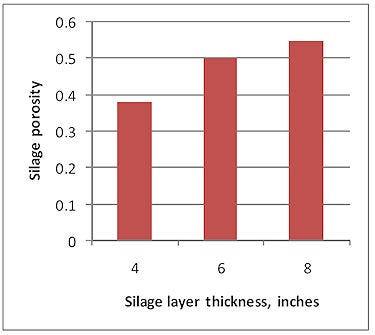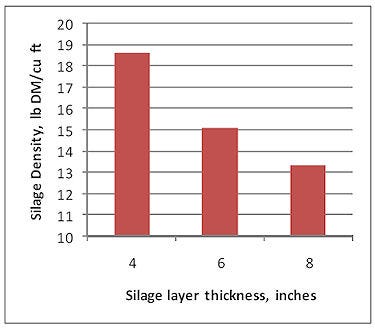
One of the simplest and most overlooked factors when making good silage is packing. Packing is important whether silage is made in a bunker, tower silo, tube or wrapped bale. Well packed silage/baleage will:
have less dry matter loss during fermentation. Plant and microbial respiration during the initial, aerobic stage of fermentation can result in 5 percent to 20 percent dry matter losses (higher with less packing). Starches and sugars are converted to carbon dioxide and heat resulting in dry matter and TDN loss.
allow storage of more dry matter in the same space of bunker, tube, or wrapped bale. Going from 33 to 38 lbs as fed silage per cubic foot allows approximately 14 percent more dry matter storage in the same space.
begin to mold more slowly on feedout. Increased packing density means less silage porosity so that oxygen cannot move through it as quickly; thus well packed silage will begin to mold more slowly on feedout.
How much packing do you need? General recommendations are for at least 44 pounds of silage as fed per cubic foot, or 15 pounds dry matter silage per cubic foot but, most importantly, that silage porosity be less than 0.40. Brian Holmes and Richard Muck have written a spreadsheet that allows you to calculate the packing you need based on your situation for bunker silos. You can download it from the University of Wisconsin Team Forage Web site HERE.

Packing density is affected by silage moisture content, silage particle size (except for bales) and degree of packing. In a bunker the degree of packing is affected by the layer thickness of silage spread over the pile, the weight of the packing tractor(s) and the time they spend packing.
Thus, for example, if silage is being chopped at 40 percent dry matter and delivered to the bunker at 40 tons as fed per hour and packed with two 20,000 pound tractors, the silage density and porosity are shown in the figure from three different layer thicknesses used to spread and pack the silage. Note that while a six-inch packing layer gives adequate density (15.1 pounds dry matter per cubit foot), desired porosity (is less than.40) was not reached until the packing layer thickness approached 4 inches.

What changes could be made to meet desired density and porosity goals? The simplest is to harvest at 35 percent moisture rather than 40 percent moisture. Then silage density with a 6-inch layer would be 14.6 pounds per cubic foot (good) and 0.43 porosity (close to desired 0.4). Another way to get desired packing density is to pack in thinner layers (4 inches rather than 6 inches) which results in a density of 18.6 pounds per cubic foot (excellent) and porosity 0.38 (very good). The third possibility is to add another packing tractor or to replace one with a bigger tractor.
These numbers demonstrate that very small differences in silage making and bunker filling practices can have a large impact of silage density and porosity affecting fermentation losses, storage capability, and feed out losses. Care should be taken as the filling season starts to have a good plan in place to achieve the desired silage density and porosity.
Density and porosity effects are similar in silage tubes and in wrapped bales. The operator should pay attention to getting good silage density through settings and operation of tube filling machines or balers.
Effect of packing layer thickness on silage density and porosity Assuming 40 tons as fed per hour delivered to bunker and two 20,000 pound tractors packing 100 percent of the time.
Undersander is a University of Wisconsin Extension and research forage agronomist.
About the Author(s)
You May Also Like




